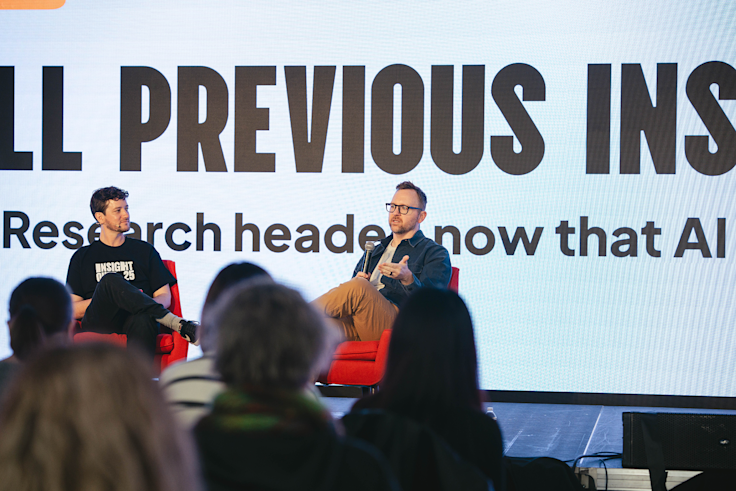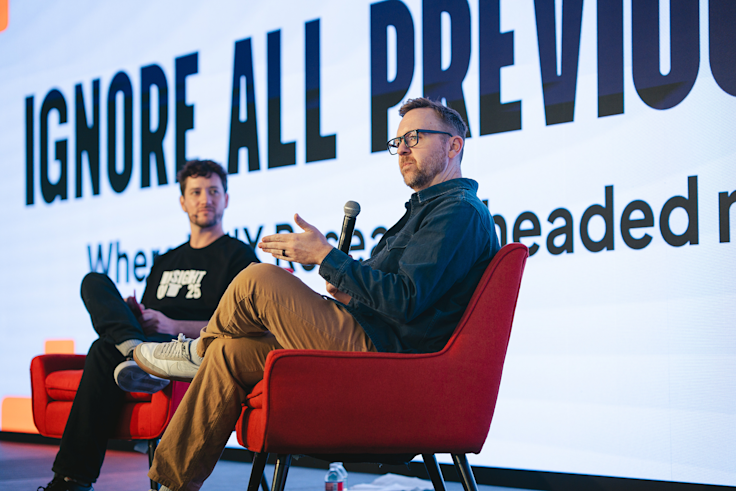Fireside Chat with Microsoft AI’s Jess Holbrook: Where is UXR headed now that AI is everywhere?
Tags
[insight out]
Published
13 June 2025
Content
Dovetail team
Creative
Sherline Maseimilian
Share

Dive into Jess Holbrook’s fireside chat on the evolving landscape of UX research and product development in the age of AI.
Speaking alongside Dovetail’s Sean Bruce at Insight Out 2025, Holbrook explores the increasing importance of deep customer understanding as a core competitive advantage and the need for researchers to embrace ownership and agency in a rapidly changing environment.
Sean Bruce: Jess, we’re clearly in a transitional moment. How would you describe what’s happening right now in product development?
Jess Holbrook: I don’t know anyone who’s having a calm, collected time right now. There’s this perpetual feeling of going faster and faster and faster. There’s a perpetual feeling of burnout being either here or around the corner.
One of the really challenging things is that we’re currently in a platform shift. Every time there’s a technological platform shift—from the mainframe to PC to web to mobile to cloud, and now to AI—they almost always enable a faster style of work. You also have that matched with a massive business opportunity that people see and don’t want to miss out on. So, it’s just going faster and faster and faster all the time right now.
Sean Bruce: I want to dig into how this is going to impact the way that teams operate in the future. Marty Cagan from SVPG recently wrote an article giving us a new vision for product teams. He broadly divides product teamwork between Discovery, which is primarily about judgment, and Delivery, which is primarily about process. Cagan’s first belief is that teams will get smaller. What are the implications for researchers when it comes to team structure changing?
Jess Holbrook: I think that’s right. It's in this context of a platform shift and in the context of tools that allow people to do things they couldn’t do before. So, I think we’ll see the normal kind of size of what we count as a team shrink. You’ll have these kind of smaller, more autonomous teams. In the article, he talks about a 20 to 30 percent reduction in the size of teams.
I think there’s going to be more of these smaller, more multidisciplinary teams that are operating a lot more autonomously and have a lot more authority in decision-making. A big part of this is because we’re shifting, and we’re not in any kind of system of optimization. When it comes to the shift to AI, we’re still kind of groping in the dark trying to figure out what the shape of the elephant is. If that’s where we are and that’s what we need to achieve, then you would actually try to get more and more people looking in more and more different ways as quickly as you can to figure out where the value is and where we should invest more.
Sean Bruce: Cagan doesn’t leave much room for researchers in his vision. Why do you think that is?
Jess Holbrook: He parses things out between discovery and delivery. If you look at it and say that the cost of delivery or the cost of execution is decreasing rapidly through all these tools—this “vibe coding” thing has a ton of energy right now. But if you also look at those tools and say this is probably as bad as they’re ever going to be, they’re unoptimized tools, they’re just going to get better.
So then the cost of delivery is going way, way down. Then the value will move more from people who can deliver, because that becomes more commodified, to people who can discover better. If it’s going to move to people who try to figure out what we should build, that feels like a very user-researchy, very insights-focused thing. I’m actually pretty optimistic about where things are shifting now for people who do what we do.

Jess Holbrook on stage at Insight Out 2025 alongside Dovetail's Sean Bruce. Photo: Clara Rice
Sean Bruce: You have a very interesting take on the importance of taste, and where taste kind of resides in an organization. As more of our systems and our ways of working are automated, there’s this room for something a little bit more nebulous.
Jess Holbrook: I think we’re going to move way more to this place of discovery and trying to figure out what we should build. If you look at how quickly models and capabilities and features are commoditized, it’s shocking. We’ve all really acclimated to the pace of change. If somebody released something of GPT-3 quality today, you’d just be like, “This is trash.” We get used to it so quickly.
When I look at that, and I don’t think that’s slowing down, from a technical and capabilities perspective, nothing is slowing down. So you say, “What are durable advantages then in that space? How would I make something that won’t be copied or commodified?” I genuinely think one of the very few enduring durable advantages is how much you care and know about the people who are using your products. That really feels like our thing. You see a lot of companies release a feature, and then everybody releases a feature, right? And it’s because they don’t have any point of view about where they’re headed, they don’t have any inspiration other than each other. When you’re stuck there, you’re just kind of stuck in this loop, and a lot of these things are just random experiments. But one of the most enduring advantages is going to be if you know and you care and you really care about other people doing better because of the things you’ve built. Then I think that’s going to be an enduring advantage for some of these companies.
Sean Bruce: I tend to agree. As the cost of building goes to zero and everything from design to the code that we build is commoditized, the last remaining thing that we have is what we know about our customers.
Jess Holbrook: Yeah, and I think that as the technology comes down as well, the barriers of influence are going to come down a lot. For anyone who’s been doing this for a while, you know there are all these frustrations that have come up before us: “I do the research, but the designer won’t design it.” “I do the research, but the PM ignores it." "I do the research, but the engineers won’t build it.” A lot of those walls are coming down. A year from now, I wouldn’t be shocked if we could be doing something like this: As I’m interviewing somebody in a study session, we’re going to feed that dialogue straight to a model, with consent. We’re going to feed that directly to a prototyping model as they’re speaking. I’m going to talk to them for about 20 to 30 minutes, and they’re going to describe their life and describe what they’d like, and then the prototype will be built in the background. Then literally the next half of the session will just be, “So here’s the prototype we built exactly for you to give feedback on it.” I think that will be a commonplace way we will do our job. I think like in a year, maybe 2 years.

Jess Holbrook speaking at Insight Out 2025. Photo: Clara Rice
Sean Bruce: So let's stick in a little bit more to what sort of skills researchers should be getting better at. Where should they be emphasizing their development?
Jess Holbrook: I think part of this will be letting go a bit or having a loose grip on what you thought being a UX researcher or insights person was. And being aligned with why you’re doing what you’re doing, but then becoming flexible in how you might accomplish that.
So I look at how I can more effectively do those things, and so maybe I step into a role that looks a little bit more like what a PM does right now. I have research at the core, but there’s no reason I can’t come back and say, “Here’s a report and here’s what we should do and here’s some recommendations.”
I think we really will need to amp up the “I don’t do research, I do research so I can create something and try to get it in people’s hands quickly.” And I have ownership over that, and I want that. I do believe that if you think you’re building something that will make somebody’s life better, you almost in some ways have a moral obligation to make that happen.

Frontier stage at Insight Out 2025. Photo: Clara Rice
Sean Bruce: So let’s recap for a second. Roles are going to collapse into a generalized goo of multi-cross-functional skills, where the keys to the castle will be owned by those who can ask the right questions and get the right answers to some of the toughest problems about our customers and make the best products. Is this current accelerated present that we’re in actually a permanent state, or does it settle into something a bit more stable?
Jess Holbrook: I think we’re having a bit of a task unbundling, and it’s not just us—this is happening to all the roles. Automation comes for tasks in all roles eventually. But you have to look at it like, “Well, no, you can go do part of another role now.”
I think that we’re doing this unbundling, and everyone’s trying to figure out what the new rebundling is. We’ll reach some new equilibrium. We don’t know what the equilibrium is now because we’re in transition. It will remain accelerated until we do, until we reach some form of an optimization phase. But also, if I look at each platform shift, we never reverted back to the speed of the previous platform shift. Things never went back. So we are step-functioning up. It will remain, but then also we’re going to figure out sustainable ways to do it. Customer connection and staying close to people and being inspired by people, I see it as ascendant in this, and I think that’s going to be a good thing.
Watch the full session and discover more talks and panels from Insight Out 2025 on YouTube.
Interview questions and answers have been edited for clarity and length.
Related Articles
